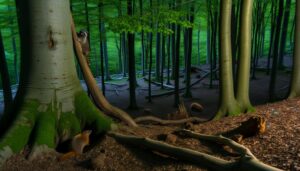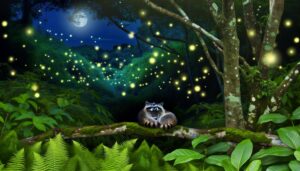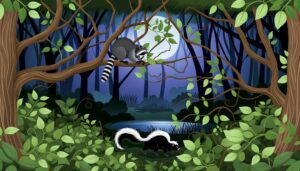Do Raccoons Live in Swamps?
Raccoons are known for their ecological versatility and can indeed inhabit swamp environments. Swamps provide an ideal habitat with abundant food sources such as aquatic organisms and plant matter.
Raccoons' proficiency in swimming and climbing, coupled with their nocturnal and scavenging behaviors, allows them to exploit swamp ecosystems efficiently. Their dexterous front paws and waterproof fur further enhance their survival in wet conditions.
Despite challenges like alligators and snakes, raccoons benefit from the diverse biodiversity and natural shelters swamps offer. To explore more about how raccoons navigate and thrive in swamp habitats, further insights await.
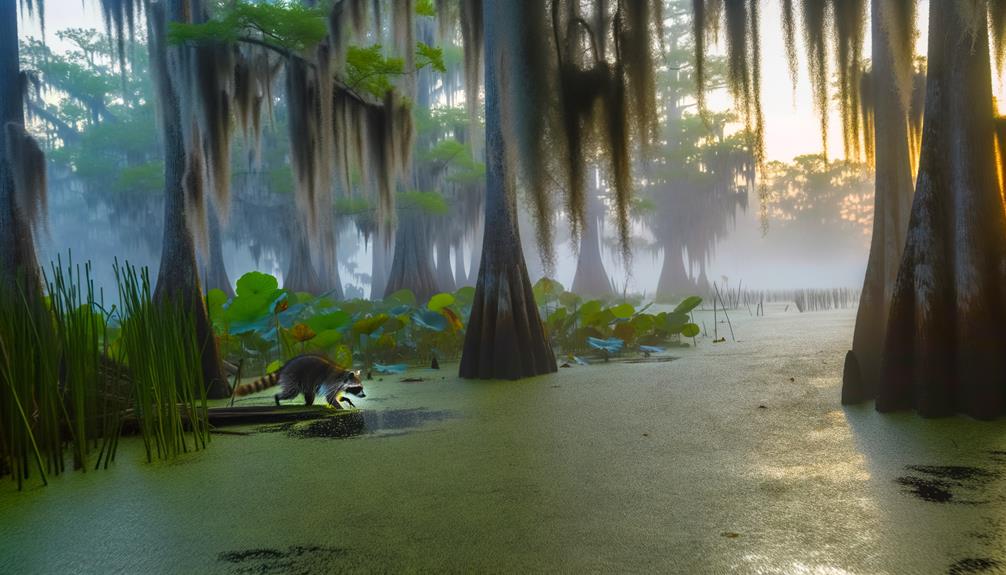
Key Takeaways
- Raccoons thrive in swamps due to their adaptable nature and diverse diet.
- Swamps provide abundant food sources such as aquatic organisms and plant matter for raccoons.
- Raccoons' proficiency in swimming and climbing makes swamps an ideal habitat.
- Nocturnal behavior and dexterous front paws help raccoons forage efficiently in swamp environments.
- Swamp habitats offer raccoons natural shelter and opportunities to evade predators.
Understanding Raccoon Habitats
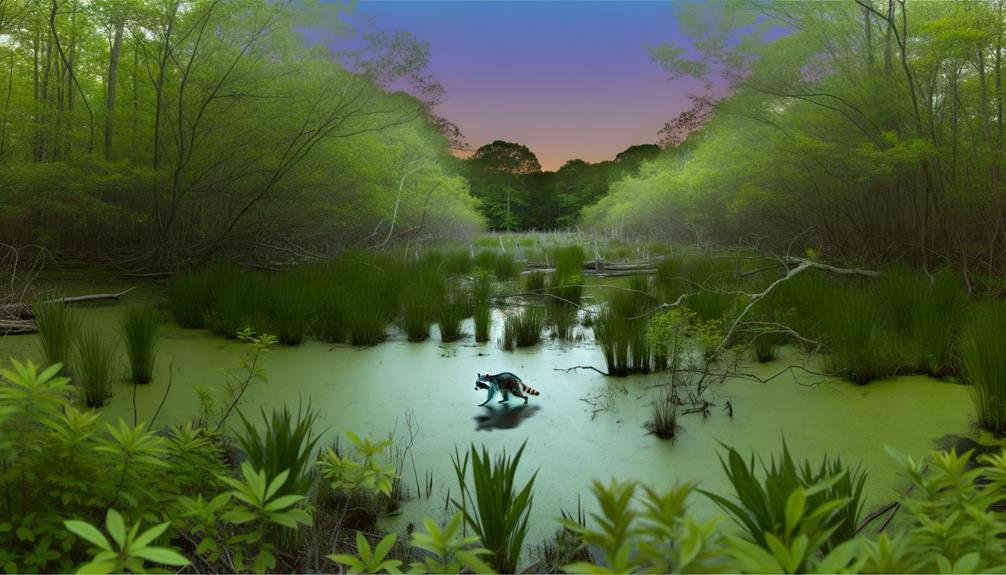
The ecological niche of raccoons (Procyon lotor) is characterized by their adaptability to diverse habitats, including the challenging environments of swamps. Raccoons exhibit remarkable ecological plasticity, enabling them to thrive in various ecosystems, from urban areas to dense forests.
Their omnivorous diet, which includes fruits, insects, small vertebrates, and aquatic organisms, allows them to exploit a wide range of food resources. Additionally, raccoons possess dexterous front paws, aiding in the manipulation and foraging of food in complex terrains.
Their nocturnal behavior minimizes competition and predation risks, facilitating their survival in swampy regions. Moreover, raccoons are proficient swimmers, a trait beneficial for maneuvering the aquatic landscapes of swamps, enhancing their ability to locate and access food sources.
Characteristics of Swamp Environments
Swamps, characterized by their saturated soils, standing water, and dense vegetation, present a unique and challenging environment for wildlife, including raccoons. These ecosystems are typically found in low-lying areas where water accumulates, creating a mix of aquatic and terrestrial habitats.
The soils in swamps are often rich in organic material, fostering a diverse array of plant species such as cypress trees, mangroves, and water lilies. The dense vegetation provides both shelter and food sources for various animal species. Additionally, the standing water can range from shallow pools to deeper channels, affecting the types of organisms that can thrive.
The dynamic water levels and dense plant cover create a complex habitat that supports a wide variety of wildlife.
Raccoons in Wetland Areas
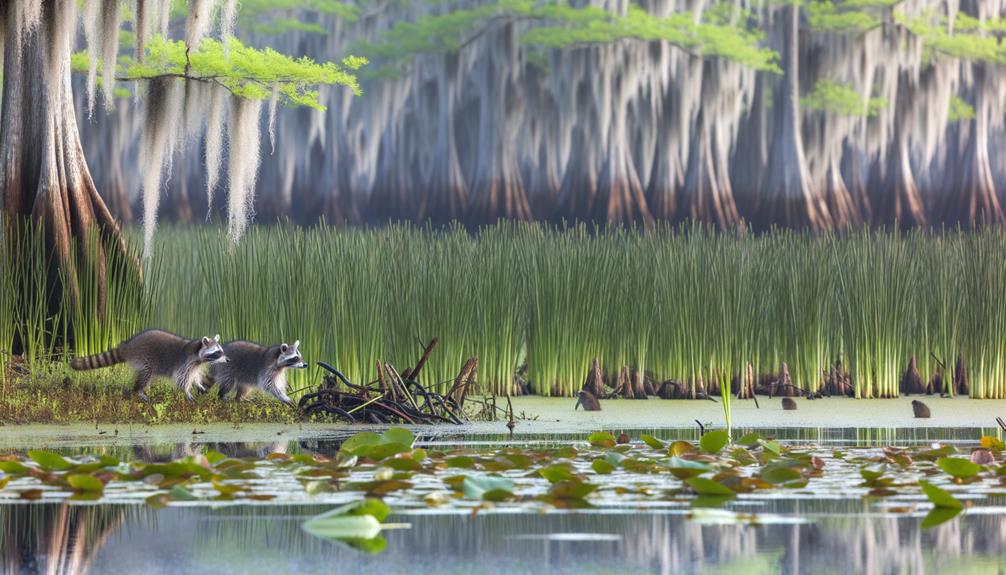
Raccoons exhibit remarkable adaptability in wetland areas, utilizing the diverse resources and habitats provided by these ecosystems to thrive. Wetlands, characterized by their saturated soils and abundant water sources, offer raccoons ample opportunities for foraging and shelter.
These mammals are proficient swimmers and climbers, allowing them to navigate the complex terrain of wetlands efficiently. Their diet is highly varied, including aquatic organisms and plant matter, which aligns well with the biodiversity present in wetland environments.
Additionally, raccoons use the dense vegetation and tree cavities found in these areas for nesting and protection against predators. This ability to exploit the multifaceted resources in wetlands underscores the raccoon's ecological plasticity and success in such habitats.
Swamp Food Sources for Raccoons
Abundant in swamps, the diverse array of food sources available to raccoons includes both animal and plant matter, providing the necessary nutrients for their survival and reproductive success. Raccoons are opportunistic feeders, and their diet typically comprises a variety of easily accessible items.
- Aquatic invertebrates: Raccoons often consume crayfish, snails, and insects found in swamp waters.
- Amphibians and small vertebrates: Frogs, fish, and small reptiles are common prey.
- Plant matter: Berries, fruits, and nuts are significant components of their diet.
- Human refuse: Raccoons may scavenge garbage or discarded food from nearby human habitats.
This diverse diet aids raccoons in thriving in swamp environments, balancing their nutritional needs with the ecological offerings of their habitat.
Raccoon Behavior in Swamps
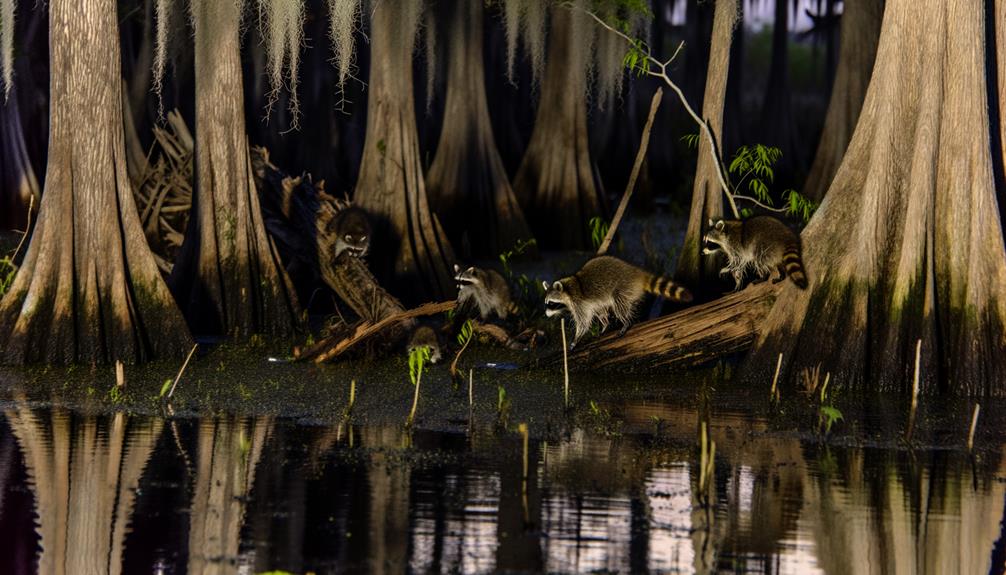
Raccoons in swamp environments exhibit distinct nocturnal activity patterns, which are influenced by the availability of food sources and predator avoidance strategies.
Their foraging behavior is adapted to the swamp's unique ecosystem, involving a diet rich in aquatic organisms, small mammals, and plant matter.
These behaviors are critical for understanding their ecological role and interactions within the swamp habitat.
Nocturnal Activity Patterns
Characterized by their adaptability, raccoons exhibit distinct nocturnal activity patterns that are particularly pronounced within swamp environments. These crepuscular and nocturnal creatures have evolved to make the most of the low-light conditions prevalent in swamps, which offer ample opportunities for foraging and exploration. Their nocturnal behavior is driven by a combination of environmental cues and the need to avoid diurnal predators.
Peak Activity Times: Raccoons are most active during dusk and dawn, capitalizing on twilight periods.
Navigational Skills: Utilizing their acute sense of touch and memory, raccoons efficiently navigate complex swamp terrains.
Shelter Seeking: They often rest in tree hollows or dense vegetation during daylight hours.
Behavioral Adaptations: Their nocturnal habits reduce competition with other species for resources.
Foraging and Diet
The foraging behavior of raccoons in swamp ecosystems demonstrates a remarkable adaptability to diverse and fluctuating food sources, driven by their omnivorous diet. This versatility enables raccoons to exploit a wide array of available resources, including aquatic organisms such as fish, amphibians, and crustaceans, as well as terrestrial food items like fruits, nuts, and small mammals.
Their dexterous front paws allow them to manipulate and extract food from various substrates, including muddy banks and dense vegetation. Seasonal variations in food availability further influence their dietary habits, with raccoons adjusting their foraging strategies accordingly.
This ecological flexibility not only supports their survival but also underscores their role in the trophic dynamics of swamp habitats.
Challenges of Swamp Living
Negotiating the dense vegetation and fluctuating water levels in swamp environments presents significant challenges for raccoons. These amphibious habitats require raccoons to adapt their foraging strategies and locomotion skills.
The thick underbrush and waterlogged terrain can impede movement, making it difficult for these animals to search for food or escape from threats. Additionally, raccoons must contend with variable water levels that can submerge their dens or alter the availability of food sources.
Key challenges include:
- Navigating dense vegetation: Thick plant growth can restrict movement and visibility.
- Water level fluctuations: Changes can affect den locations and access to food.
- Predation risks: Dense foliage can hide predators, complicating escape routes.
- Parasite exposure: Swamp environments can harbor a higher density of parasites.
Swamp Predators of Raccoons
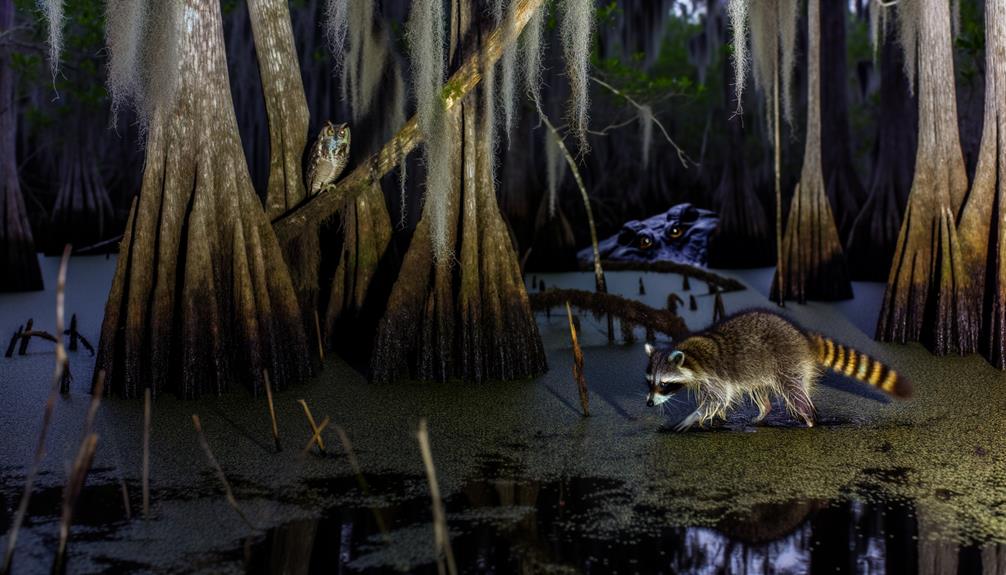
Raccoons residing in swamp ecosystems face significant predation risks from several apex predators. Alligators pose a substantial threat due to their ambush hunting techniques and aquatic adaptability.
Additionally, various snake species, including large constrictors and venomous varieties, present considerable danger to raccoons through both direct predation and defensive encounters.
Alligator Threats
In the complex ecosystem of swamps, alligators pose an important predatory threat to raccoons, influencing their behavior and habitat utilization. These apex predators exert significant pressure on raccoon populations, leading to various adaptive strategies.
- Predation Risk: Raccoons must constantly assess predation risk when foraging near water bodies where alligators are present.
- Avoidance Behavior: Increased nocturnal activity and preference for arboreal refuges are noted in raccoons to mitigate encounters.
- Habitat Selection: Raccoons may select habitats with dense vegetation or elevated areas less accessible to alligators.
- Dietary Adjustments: Altered foraging patterns can lead to shifts in diet, as raccoons avoid areas frequented by alligators.
Understanding these dynamics is important for comprehending swamp ecology and raccoon survival strategies.
Snake Encounters
Among the various predators in swamp ecosystems, snakes represent a significant threat to raccoons, necessitating vigilant behavior and adaptive strategies for survival. Venomous species such as cottonmouths and rattlesnakes pose a direct danger through their toxic bites, which can incapacitate or kill raccoons. Constrictor species, such as pythons, can overpower raccoons through sheer strength. Raccoons employ keen senses and agile movements to detect and evade these threats. Understanding the interplay between raccoons and snakes in swamp habitats is essential for comprehending predator-prey dynamics.
| Predator Type | Impact on Raccoons |
|---|---|
| Cottonmouth | Venomous bites, potential fatality |
| Rattlesnake | Venomous bites, potential fatality |
| Python | Constriction, potential fatality |
| Detection | Raccoons use sharp senses |
| Evasion | Nimble movements to avoid danger |
This table outlines the primary snake threats and raccoon responses.
Benefits of Swamp Habitats
Swamp habitats offer a unique blend of resources and environmental conditions that are highly beneficial for raccoons. They provide abundant food sources, natural shelter, and relative protection from predators. These ecosystems are rich in biodiversity, supporting a variety of flora and fauna that serve as prey and foraging opportunities for raccoons.
Additionally, the dense vegetation and waterlogged terrain create natural refuges that raccoons utilize for nesting and evading threats. The intricate network of water channels and marshes further enhances their ability to avoid larger predators.
- Diverse food availability: Insects, amphibians, small mammals, and plant matter
- Natural shelter: Dense foliage and hollow trees
- Moist environment: Access to drinking water and food washing
- Predator evasion: Complex terrain and water barriers
These factors collectively make swamps highly conducive to raccoon habitation.
Raccoon Adaptations to Swamps
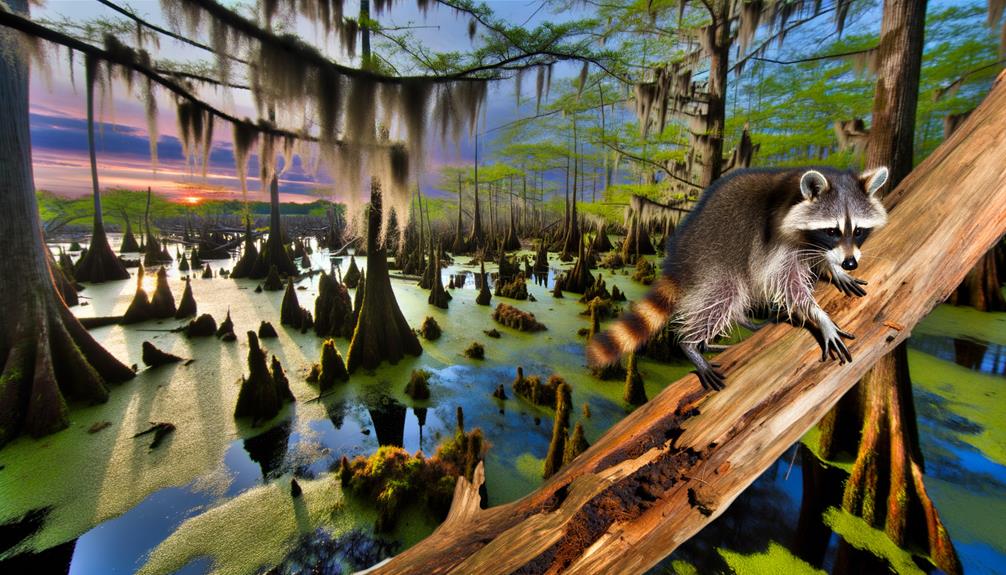
Capitalizing on the myriad benefits provided by swamp habitats, raccoons have developed a range of physiological and behavioral adaptations that enable them to thrive in these challenging environments.
Their dexterous front paws are highly sensitive, allowing them to detect and manipulate prey items hidden in muddy water. In addition, raccoons possess a waterproof fur coat that insulates them against the damp and cold conditions prevalent in swamps.
Nocturnal foraging behaviors align with the activity patterns of many swamp-dwelling prey species, ensuring efficient energy uptake. Moreover, their opportunistic diet, including aquatic organisms, plants, and small vertebrates, demonstrates remarkable dietary flexibility.
These adaptations collectively enhance the raccoons' survivability and reproductive success in swamp ecosystems.
Conclusion
Raccoons thrive in swamp habitats, much like adaptable athletes in diverse environments. Swamps offer abundant food sources and concealment from predators, making them suitable for raccoon populations. Despite the challenges posed by wetlands, such as fluctuating water levels and the presence of larger predators, raccoons exhibit remarkable behavioral and physiological adaptations.
These include their dexterous paws and opportunistic feeding habits. Consequently, swamps provide both opportunities and obstacles, shaping raccoon behavior and survival strategies in these unique ecosystems.

